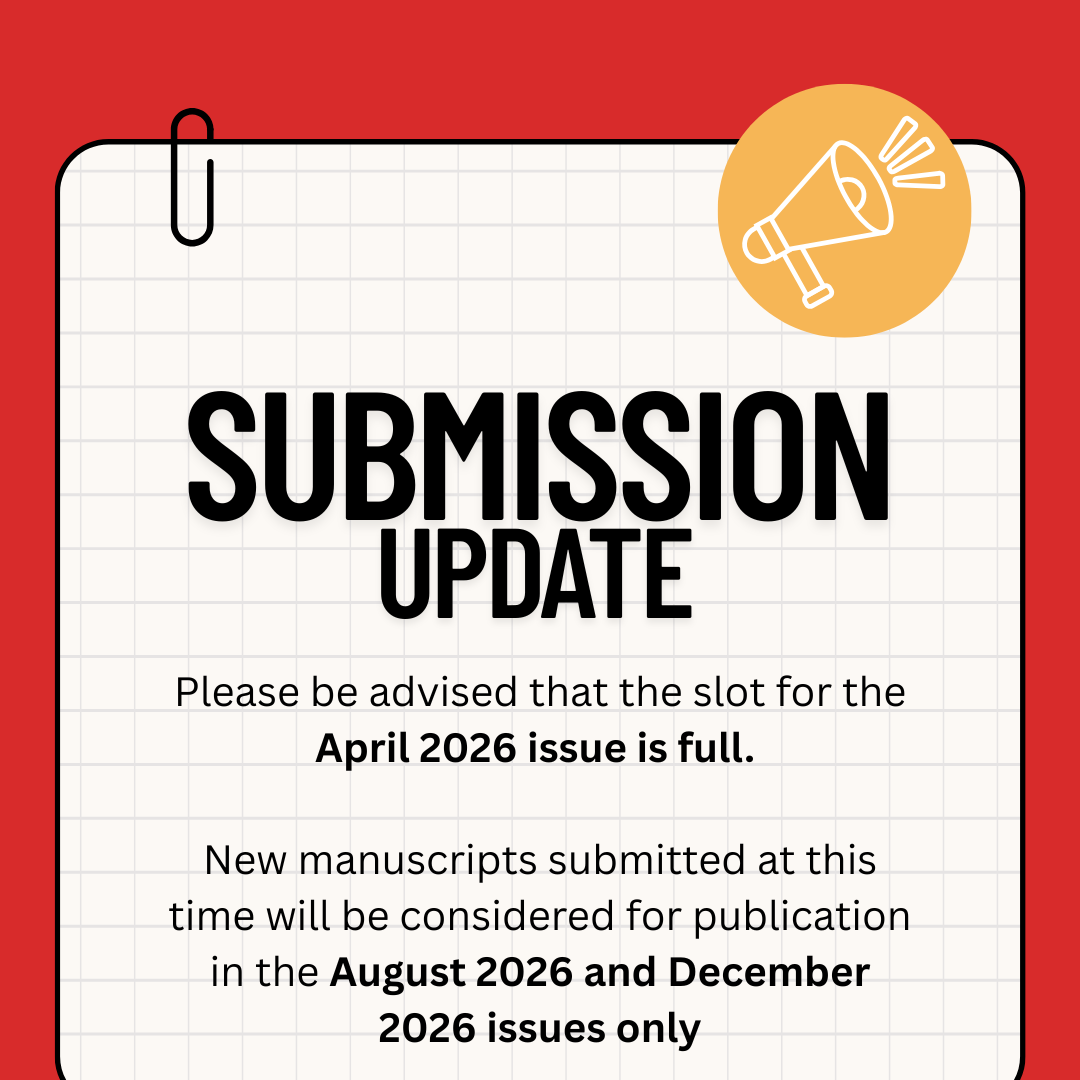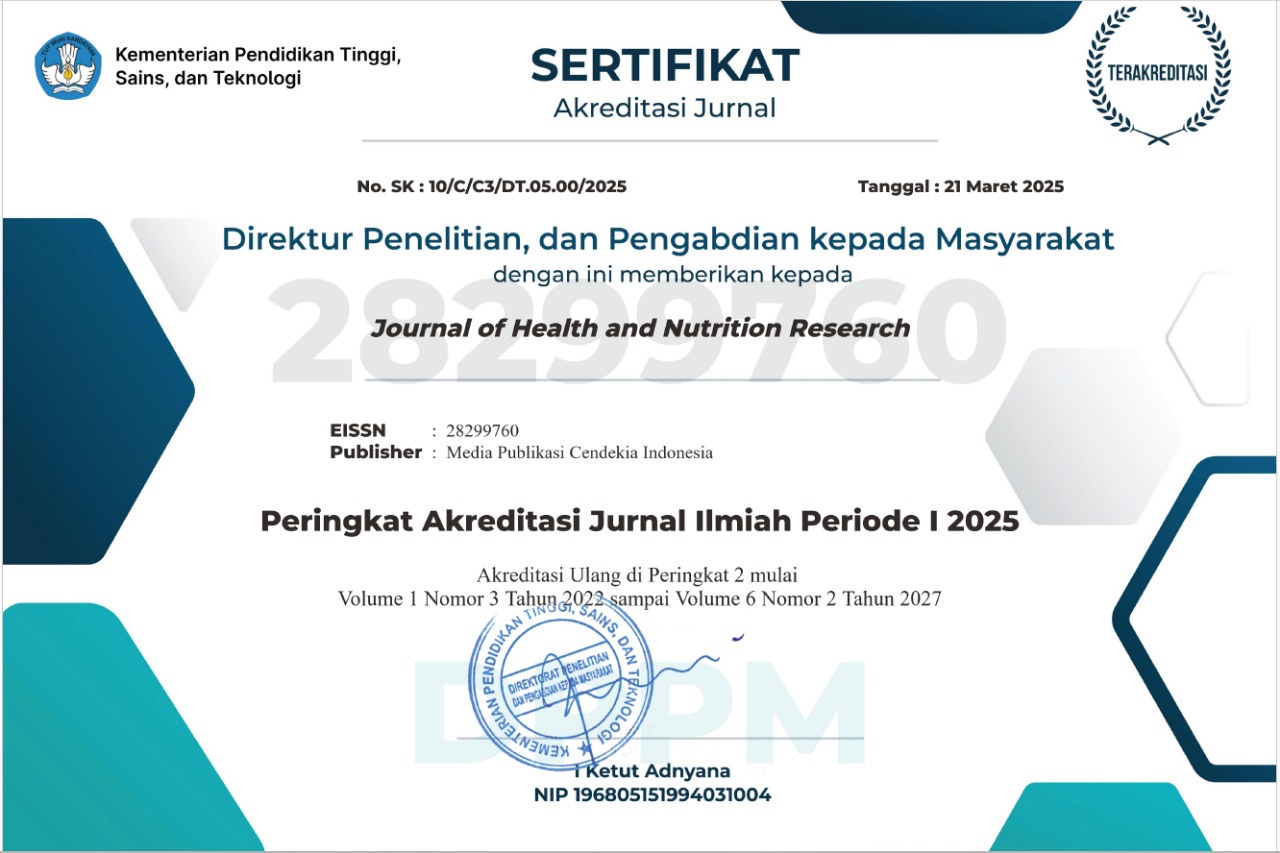The Relationship Between Macro-Nutrient Intake, Food Security, and Nutrition-Related Knowledge with The Incidence of Stunting in Toddlers
Keywords:
Macro Nutrients Intake, Food Security, Nutrition-Related Knowledge, Stunting, ToddlersAbstract
Stunting is a condition of impaired growth in toddlers due to prolonged nutritional deficiencies. This issue is a significant global nutritional problem, particularly in poor and developing countries, including Indonesia. This study aims to examine the relationship between macronutrient intake, food security at the household level, and nutrition-related knowledge on the incidence of stunting among toddlers in the working area of Cimarga Health Center. This study employed a cross-sectional design. The sample size consisted of 99 toddlers from 11 villages within the Cimarga Health Center's jurisdiction. Analysis was conducted using the Chi-Square test. The findings reveal a stunting prevalence of 34.3% among toddlers. There is a significant relationship between household food security (p=0.014) and the incidence of stunting (OR=1.630; 95% CI=1.381-1.923). However, no significant relationships were found between energy intake (p=0.140), carbohydrate intake (p=0.544), protein intake (p=0.607), fat intake (p=0.439), and maternal nutrition knowledge (p=0.411) with the incidence of stunting in toddlers in the Cimarga Health Center area. This study underscores the importance of enhancing household food security as a primary strategy to reduce stunting despite the lack of significant relationships between macro-nutrient intake and maternal nutrition knowledge
Downloads
References
UNICEF, WHO, World Bank. Levels and trends in child malnutrition, UNICEF/WHO/World Bank Group – Joint Child Malnutrition Estimates 2021 edition. UNICEF; 2021.
FAO. Asia and the Pacific Regional Overview of Food Security and Nutrition 2018 – Accelerating progress towards the SDGs. Bangkok: Food and Agriculture Organization; 2018. 96 p.
Kementerian Kesehatan Republik Indonesia. Laporan Riset Kesehatan Dasar Tahun 2018 (Indonesian National Basic Health Survey in 2018). Jakarta: Kementerian Kesehatan Republik Indonesia; 2018.
Kementerian Kesehatan Republik Indonesia. Laporan Survei Status Gizi Indonesia (Indonesian Nutrition Survey Status Report). Jakarta: Kementerian Kesehatan Republik Indonesia; 2021.
Permatasari TAE, Chadirin Y, Ernirita, Elvira F, Putri BA. The association of sociodemographic, nutrition, and sanitation on stunting in children under five in rural area of West Java Province in Indonesia. J Public Health Res. 2023 Aug 30;12(3):22799036231197169.
Falmuariat Q, Febrianti T, Mustakim M. Risk Factors for Stunting in Toddlers in Developing Countries. Jurnal Ilmiah Kesehatan Sandi Husada. 2022 Dec 1;11(2):308–15.
Tebi, Dahlia, Wello EA, Safei I, Rahmawati, Juniarty S, et al. Literature Review Faktor-Faktor yang Mempengaruhi Terjadinya Stunting pada Anak Balita. Fakumi Medical Journal: Jurnal Mahasiswa Kedokteran. 2021;1(3):234–40.
Prendergast AJ, Humphrey JH. The stunting syndrome in developing countries. Paediatr Int Child Health. 2014 Apr;34(4):250–65.
Pemerintah Provinsi Banten. Laporan Penyelenggaraan Percepatan Penurunan Stunting Semester I Di Provinsi Banten [Internet]. Pemerintah Provinsi Banten; 2023. Available from: https://aksi.bangda.kemendagri.go.id/emonev/assets/uploads/laporan_pro/laporan_pro_36_periode_5_1689944093.pdf
Rahayuwati L, Komariah M, Sari CWM, Yani DI, Hermayanti Y, Setiawan A, et al. The Influence of Mother’s Employment, Family Income, and Expenditure on Stunting Among Children Under Five: A Cross-Sectional Study in Indonesia. J Multidiscip Healthc. 2023 Aug 14;16:2271–8.
Butarbutar MC, Alza Y, Atasasih H. Mother’s Knowledge Level, Eating Habits and Nutritional Status of Children (3-5 years). INCH : Journal of Infant And Child Healthcare. 2022;1(1):1–6.
Cerrato J, Cifre E. Gender Inequality in Household Chores and Work-Family Conflict. Front Psychol [Internet]. 2018 Aug 3 [cited 2024 Aug 22];9. Available from: https://www.frontiersin.org/journals/psychology/articles/10.3389/fpsyg.2018.01330/full
Astutik A, Rahfiludin MZ, Aruben R. Faktor Risiko Kejadian Stunting Pada Anak Balita Usia 24-59 Bulan (Studi Kasus Di Wilayah Kerja Puskesmas Gabus Di Kabupaten Pati Tahun 2017). Jurnal Kesehatan Masyarakat. 2018 Jan 2;6(1):409–18.
Pranindita SK, Cahyati WH. Stunting pada Balita Usia 24-59 Bulan. HIGEIA. 2022;6(4):191–202.
Widyaningsih NN, Kusnandar K, Anantanyu S. Keragaman pangan, pola asuh makan dan kejadian stunting pada balita usia 24-59 bulan. JGI. 2018 Dec 30;7(1):22–9.
Lukman S, Arbie FY, Humolungo Y. Hubungan Pengetahuan Gizi Ibu Dengan Kejadian Stunting Pada Anak Balita Di Desa Buhu Kecamatan Talaga Jaya Kabupaten Gorontalo. Journal Health and Nutritions. 2018 Mar 19;3(1):42–53.
Mutingah Z, Rokhaidah R. Hubungan Pengetahuan Dan Sikap Ibu Dengan Perilaku Pencegahan Stunting Pada Balita. Jurnal Keperawatan Widya Gantari Indonesia. 2021 Sep 27;5(2):49.
Nizmah N, Reski S, Wahyunigrum DR, Cahyono J. The Relationship of Balanced Nutrition Knowledge with the Attitudes and Behaviors of Young Women. J Health Nutr Res. 2024 Apr 10;3(1):91–8.
Spronk I, Kullen C, Burdon C, O’Connor H. Relationship between nutrition knowledge and dietary intake. British Journal of Nutrition. 2014 May;111(10):1713–26.
Uliyanti U, Tamtomo DG, Anantanyu S. Faktor Langsung dan Tidak Langsung Yang Berhubungan Dengan Kejadian Stunting Pada Anak Usia 24–59 Bulan Di Kecamatan Matan Hilir Selatan. JVK. 2017 Jul 31;3(2):67.
Saleh A, Syahrul S, Hadju V, Andriani I, Restika I. Role of Maternal in Preventing Stunting: a Systematic Review. Gaceta Sanitaria. 2021 Jan 1;35:S576–82.
Published
How to Cite
Issue
Section
Copyright (c) 2024 Khansa Nabilah, Izna Nurdianty Muhdar, Widya Asih Lestari, Sarina Sariman

This work is licensed under a Creative Commons Attribution-NonCommercial-ShareAlike 4.0 International License.
Most read articles by the same author(s)
- Nasrul Nasrul, Fahmi Hafid, Taqwin Taqwin, Hikmah, Risma, Atika Nuswantari, Sarina Sariman, Iron Supplement Consumption, Dietary Intake, Nutritional Status, and Anemia Among Adolescent Girls in Banawa, Donggala Regency , Journal of Health and Nutrition Research: Vol. 4 No. 2 (2025)
- Fahmi Hafid, Taufiqurrahman Taufiqurrahman, Hery Sumasto, Atika Nuswantari, Jazilah Nur Arifah, Sarina Sariman, Emyr Reisha Isaura, The Association Between Social Interaction and Nutritional Status: A Cross-Sectional Study in a Health-Promoting Campus Setting , Journal of Health and Nutrition Research: Vol. 4 No. 3 (2025)



















